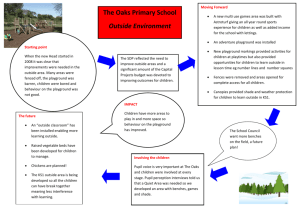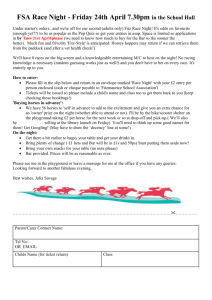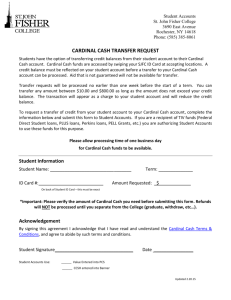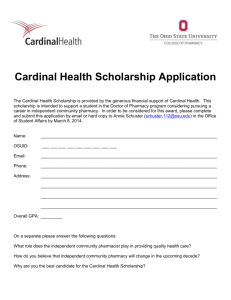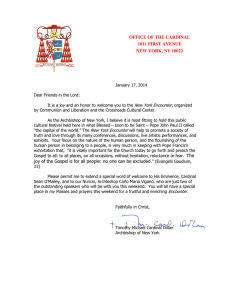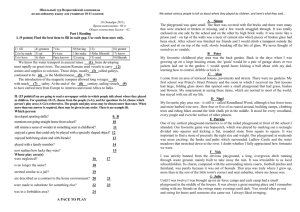Why Maps are Important - Midland Independent School District
advertisement
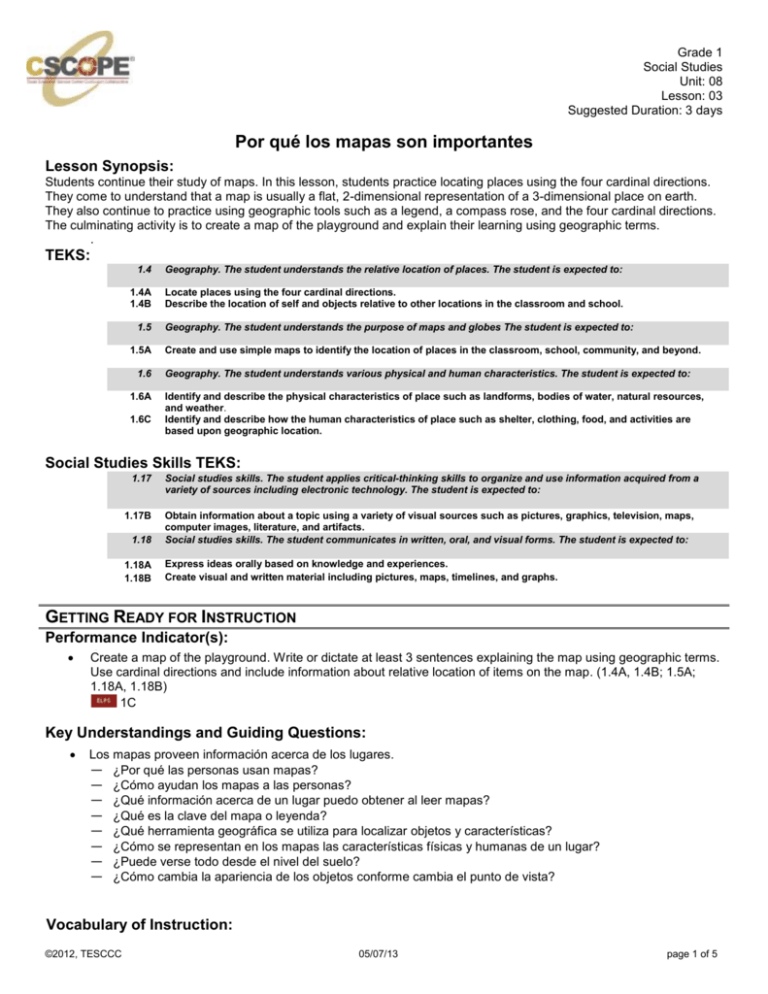
Grade 1 Social Studies Unit: 08 Lesson: 03 Suggested Duration: 3 days Por qué los mapas son importantes Lesson Synopsis: Students continue their study of maps. In this lesson, students practice locating places using the four cardinal directions. They come to understand that a map is usually a flat, 2-dimensional representation of a 3-dimensional place on earth. They also continue to practice using geographic tools such as a legend, a compass rose, and the four cardinal directions. The culminating activity is to create a map of the playground and explain their learning using geographic terms. . TEKS: 1.4 Geography. The student understands the relative location of places. The student is expected to: 1.4A 1.4B Locate places using the four cardinal directions. Describe the location of self and objects relative to other locations in the classroom and school. 1.5 1.5A 1.6 1.6A 1.6C Geography. The student understands the purpose of maps and globes The student is expected to: Create and use simple maps to identify the location of places in the classroom, school, community, and beyond. Geography. The student understands various physical and human characteristics. The student is expected to: Identify and describe the physical characteristics of place such as landforms, bodies of water, natural resources, and weather. Identify and describe how the human characteristics of place such as shelter, clothing, food, and activities are based upon geographic location. Social Studies Skills TEKS: 1.17 1.17B 1.18 1.18A 1.18B Social studies skills. The student applies critical-thinking skills to organize and use information acquired from a variety of sources including electronic technology. The student is expected to: Obtain information about a topic using a variety of visual sources such as pictures, graphics, television, maps, computer images, literature, and artifacts. Social studies skills. The student communicates in written, oral, and visual forms. The student is expected to: Express ideas orally based on knowledge and experiences. Create visual and written material including pictures, maps, timelines, and graphs. GETTING READY FOR INSTRUCTION Performance Indicator(s): C Create a map of the playground. Write or dictate at least 3 sentences explaining the map using geographic terms. Use cardinal directions and include information about relative location of items on the map. (1.4A, 1.4B; 1.5A; 1.18A, 1.18B) 1C Key Understandings and Guiding Questions: Los mapas proveen información acerca de los lugares. — ¿Por qué las personas usan mapas? — ¿Cómo ayudan los mapas a las personas? — ¿Qué información acerca de un lugar puedo obtener al leer mapas? — ¿Qué es la clave del mapa o leyenda? — ¿Qué herramienta geográfica se utiliza para localizar objetos y características? — ¿Cómo se representan en los mapas las características físicas y humanas de un lugar? — ¿Puede verse todo desde el nivel del suelo? — ¿Cómo cambia la apariencia de los objetos conforme cambia el punto de vista? Vocabulary of Instruction: ©2012, TESCCC 05/07/13 page 1 of 5 Grade 1 Social Studies Unit: 08 Lesson: 03 características físicas características humanas de un lugar vista aérea vista panorámica instrucciones cardinals leyenda Materials: Refer to the Notes for Teacher section for material Attachments: Teacher Resource: National Parks in Texas Resources and References: Advance Preparation: 1. Become familiar with content and procedures for the lesson, including the idea that maps are tools that help us locate places and objects. 2. Refer to the Instructional Focus Document for specific content to include in the lesson. 3. Select appropriate sections of the textbook and other classroom materials that support the learning for this lesson. 4. Preview websites according to district guidelines. 5. Become familiar with the content and procedures for this lesson. 6. Display vocabulary words on a “word wall” to be used during the lesson. 7. Gather picture books to use with lesson. 8. Determine which way is north in your classroom and on the playground. Prepare cardinal direction signs to be placed in your classroom and outside on the playground. 9. Prepare a list of questions about the relative location of objects on the playground (see example attached). 10. Collect a variety of maps to allow students practice in reading maps. (tourist maps, street maps, building maps, etc.) 11. Prepare materials and handouts as needed. Background Information: Physical characteristics of places are features such as landforms, bodies of water, natural resources, natural hazards, and weather. These result from climatic and tectonic processes. (Definition from The Social Studies Center) Human Characteristics of Places – features that have been added by humans such as houses Geographical Tools – legends, symbols, cardinal directions, compass rose Direction – the point toward which something faces. Example, when you ask someone to face forward, forward is a direction. When you ask someone to face north, north is a direction; it is one of the four cardinal directions. Definitions courtesy of the Social Studies Center [defunct]. (2000). Glossary. Austin: Texas Education Agency. GETTING READY FOR INSTRUCTION SUPPLEMENTAL PLANNING DOCUMENT Instructors are encouraged to supplement and substitute resources, materials, and activities to differentiate instruction to address the needs of learners. The Exemplar Lessons are one approach to teaching and reaching the Performance Indicators and Specificity in the Instructional Focus Document for this unit. Instructors are encouraged to create original lessons using the Content Creator in the Tools Tab located at the top of the page. All originally authored lessons can be saved in the “My CSCOPE” Tab within the “My Content” area. INSTRUCTIONAL PROCEDURES Instructional Procedures Notes for Teacher ENGAGE – Simon Says: Cardinal directions 1. Post cardinal direction signs appropriately in the classroom (north, south, east, and west). 2. Direct students’ attention to the cardinal direction signs posted on the classroom walls. Students read the signs. NOTE: 1 Day = 30 minutes Suggested Day 1 ‒ 5 minutes Materials: Cardinal direction signs posted correctly on classroom walls Purpose: Use Simon Says to practice cardinal directions. 3. Play Simon Says with your students using cardinal directions. ©2012, TESCCC 05/07/13 page 2 of 5 Grade 1 Social Studies Unit: 08 Lesson: 03 Instructional Procedures Notes for Teacher “Simon says, take 3 steps north. Simon says hop two steps east.” What must they do to stay in the game? Follow directions. Ask: If there were a new park near our school, how might a new student find their way to the park? (Someone could take them, they could get directions from someone, they could get a map and follow it, etc.). EXPLORE – Bird’s Eye View 1. Display the pictures of parks from Lesson 1 in this Unit and review the list of the physical characteristics and the human characteristics found in the park. Read the list of everything they see in the pictures. Ask questions such as: What might happen if you were in an airplane looking down on these two pictures? What might you see? How would the park look? 2. Students turn and talk and come to the following or similar conclusions: see more area see things at a different angle TEKS: 1.4A; 1.4B; 1.5A; 1.6A; 1.6C; 1.17B; 1.18A; 1.18B Suggested Day 1 (continued) ‒ 10 minutes Materials: Computer with Google Earth downloaded Purpose: Learn how perspective affects perception TEKS: 1.4A; 1.4B; 1.5A; 1.6A; 1.6C; 1.17B; 1.18A; 1.18B Instructional Note: Consider an internet search for maps with a “bird’s-eye” view of a community. 3. Are there other places besides an airplane where you might see a park from a different angle? (A high building, a hot air balloon, the top of a tree, riding on or putting a camera on a bird’s back – a bird’s-eye view) 4. Access prior learning from the previous lesson (Unit 7, Lesson 2) regarding online or satellite maps, GIS, etc. 5. View the local community from a satellite virtual map or GIS program (such as Google Earth). Find your town/school and then show students. Walk students through a relative location in regards to where they are viewing. EXPLAIN – Draw a map 1. Students place several items on the floor near their desks (a pencil, an eraser, etc.) and stand above them looking down. Students sketch the items from this perspective. 2. Students pick up the objects and trade with a partner. The partner then looks at the sketch and places the objects in the same place as indicated on the map. 3. Students describe to one another the location of the objects on the map using the cardinal directions as well as terms of relative location. ENGAGE – Recall walk from previous lesson 1. Prompt students to recall the walk they took around the school to look for human and physical characteristics of place. Suggested Day 1 (continued) ‒ 10 minutes Materials: Drawing paper, 8 ½ X 11, or similar size Purpose: Students use what they learned about bird’s-eye view to draw and describe a map. TEKS: 1.4A; 1.4B; 1.5A; 1.6A; 1.6C; 1.17B; 1.18A; 1.18B Suggested Day 2 ‒ 5 minutes Purpose: Remember human and physical characteristics of place from previous lesson. 2. Facilitate a discussion to recall those characteristics. TEKS: 1.4A; 1.4B; 1.5A; 1.6A; 1.6C; 1.17B; 1.18A; 1.18B ©2012, TESCCC 05/07/13 page 3 of 5 Grade 1 Social Studies Unit: 08 Lesson: 03 Instructional Procedures Notes for Teacher EXPLORE – Take a walk Suggested Day 2 (continued) ‒ 10 minutes Materials: Cardinal direction signs (from the Engage section) 1. Students take another walk around the school. Students take the lists they made before. 2. Students speculate on what they might see from the top of the school building or from the top of any tall building surrounding the school. (If there isn’t a tall building nearby, have students imagine or remember if they had flown in an airplane, etc.) How is perspective different from a very high place? Purpose: Practice following cardinal directions. TEKS: 1.4A; 1.4B; 1.5A; 1.6A; 1.6C; 1.17B; 1.18A; 1.18B 3. Place cardinal directions signs on the playground. 4. Again play Simon Says. Students follow your directions to practice. Instructional Note: Prepare cardinal direction signs and questions for the playground. 5. Take students on a “tour” of the playground by giving directions. For example: Stand near the jungle gym and ask students to look east. Ask questions such as: What is east of the jungle gym? What direction do we need to walk to get to the soccer field? EXPLAIN – Answer questions with a partner 1. Distribute student questions such as the following: (Sample questions to use as an example. Write questions that go with your playground.) _______ is on the north end of the playground. To get to the playground, we traveled ______ from the school. The swings are ____ of the soccer field. The sandbox is ______ of the swings but ______ of the ____. Suggested Day 2 (continued) ‒ 5 minutes Materials: Teacher-created questions about playground Purpose: Answer questions about the playground using correct location vocabulary. TEKS: 1.4A; 1.4B; 1.5A; 1.6A; 1.6C; 1.17B; 1.18A; 1.18B 2. In pairs while still on the playground, students answer the questions. EXPLORE – Create a map 1. Tell the students a classic fairy tale of a person or animal that moves from one location to another. 2. Students retell the story to you as you create a map on chart paper or using a projection system. 3. Label your map with the cardinal directions (N S E W) and have the students retell the story (chronological order), using the proper directions when telling you what comes next for your map (relative location). Suggested Day 2 (continued) ‒ 10 minutes Materials: Picture books of the fairy tale or other suggested books about mapping Chart paper or projection system Attachments Teacher Resource: National Parks in Texas 4. Guide students in creating a legend for your map and discuss the need for this. Use textbook information if necessary to aid with students’ understanding of the use of a map key. 5. Display the map of National Parks in Texas. Guide students in creating a legend for the map with symbols for highways, rivers, and the parks. ©2012, TESCCC 05/07/13 page 4 of 5 Grade 1 Social Studies Unit: 08 Lesson: 03 Instructional Procedures Notes for Teacher 6. Use the Teacher Resource: National Parks in Texas to demonstrate that maps show a very effective set of directions: NSEW and practice the idea of directions between two points (parks). Example: Big Thicket is north of Padre Island. 7. Students use the map to give relative directions between various places. Example: Big Thicket is north of Padre Island. ENGAGE/ELABORATE – Purpose of maps Suggested Day 3 ‒ 5 minutes Materials: Maps: tourist maps, maps of school, maps of buildings, maps of towns, etc. (Many are available online, or use maps from places you have visited.) 1. Display a variety of maps. 2. Students explore the maps and legends. 3. Ask questions such as: Why would you need a map? Where have you seen a map being used? Who uses a map for their work? Purpose: Examine a variety of maps to provide more information before drawing a map. TEKS: 1.4A; 1.4B; 1.5A; 1.6A; 1.6C; 1.17B; 1.18A; 1.18B EVALUATE – Create a map of the playground Create a map of the playground. Write or dictate at least 3 sentences explaining the map using geographic terms. Use cardinal directions and include information about relative location of items on the map. (1.4A, 1.4B; 1.5A; 1.18A, 1.18B) 1C 1. Take students to the playground again with clipboards, paper, and pencils. 2. Provide students an opportunity to observe and make notes regarding the relative location of human and physical characteristics on the playground. Suggested Day 3 (continued) ‒ 25 min Materials: White drawing paper, 8 ½ X 11 or 11 X 18 Clipboards Pencils Instructional Note: Place cardinal direction signs out on the playground before this activity. Students will need one paper for the map and a separate piece of paper for the explanation. You may choose to have students gather their information and make a sketch while outside, but complete the drawing and writing back in the classroom. 3. Using the legend and notes made previously, students create a map of their playground including the legend for their map and at least 3 sentences explaining the map using geographic terms. For example: The swings are north of the tree. ©2012, TESCCC 05/07/13 page 5 of 5
